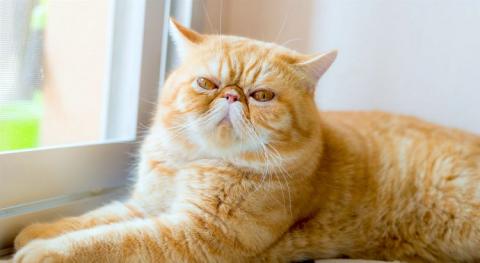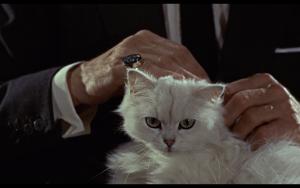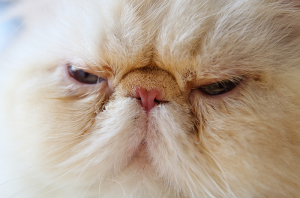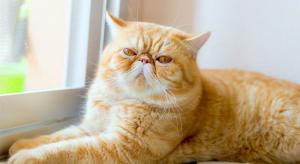So many cat breeds are becoming more and more extreme at the cost of our cats' health. Learn how to avoid extreme breeds.

Unfortunately extremity seems to be the flavour of the decade, and the trend has led to a number of extreme cat breeds being developed. If you are relatively new to the world of pedigree cats, no doubt you will be overwhelmed by choice. There are so many pedigree cat breeds available to us these days, that it can be hard to choose a kitten.
The GCCF recognises 40 different breeds and TICA recognises a staggering 71 breeds of cat! Then within each of those breeds are all of the different colours and variations available...so choosing a kitten can be a mammoth task!
Unfortunately, the current trend for ‘cuteness’ has driven some breeds towards more and more extreme versions of themselves, and is driving the trend for extreme cat breeds.
Clearly, in the wild, only those animals that are the healthiest, fittest and strongest thrive: they are able to catch more food, find suitable mates, and rear kittens most successfully. Extreme cat breeds simply would not survive in the wild.
In captivity, cats are fed and cared for by their owners, or breeders, and therefore even those cats that would not thrive in the wild can continue to breed. This means that traits that would ordinarily make an animal less successful, and therefore would mean that animal would probably not have any, or many offspring, can be proliferated easily by breeders.
As these unusual traits get bred from more and more, they become ever more pronounced. The more pronounced they become, the more of a health issue they are. Unfortunately these traits have become so extreme in several cat breeds that they are now affecting the quality of life and the health of the cats.
Examples of extreme cat breeds
-
Persian cats
Extreme cat breed trait: very flat faced
If you see a photograph of a Persian cat from 20 years ago, and then compare it to a Persian today, you will see how much damage can be done to a breed in a relatively short time. The original ‘Bond’ cat (Blofeld’s cat in From Russia with Love) was a white Persian cat with beautiful green eyes:

And below is a photograph of a recent Persian cat, with an extremely flat face.

Probably most people would agree that the first cat is far more beautiful than the second. The first cat will also be far more healthy than the second (Persian cats with extremely flat faces suffer from pain, brain deformities and holes in their skulls as well as breathing difficulties). These two images show the dangers of breeding to extremes. Read more about extremely flat faced cats.
-
Exotic Shorthairs
Extreme Trait: very flat faced
Exotic Shorthairs are basically a short-haired version of a Persian cat, and have unfortunately suffered the same fate as their long haired counterparts.

-
Munchkin cats
Extreme Trait: dwarfism
Munchkins are not actually a 'breed' of cat. They are simply cats that have the gene for dwarfism. Breeders then breed cats together with the dwarfism gene to further exaggerate the trait, and this results in what we call 'munchkin' cats. Unfortunately cats with dwarfism suffer from many wide and varied health complications, including limb and skeletal deformities and resulting pain. On top of that, munchkin cats have unusually short legs that make them unable to jump and very immobile, and this can cause further health problems.
-
Teacup cats
Extreme Trait: dwarfism/small size
Like munchkin cats, teacup cats are also not a breed of cat. Teacup cats are the result of selective breeding for small size. That may seem relatively harmless, but the problem is that after multiple generations of breeding for unusually small cats, health issues can arise. Problems with births can happen, putting mum and kittens at risk. Additionally, the size of the breeding gene pool becomes so small that inbreeding coefficients soar, and that in itself can cause serious helath problems and inbreeding depression.
-
Manx cat
Extreme Trait: spine deformities
The cause of the Manx cat's missing tail is actually a genetic deformity which prevents the spine from forming properly. The gene that causes the deformity is a dominant gene, so a kitten only needs to inherit it from one parent. If a kitten inherits it from both parents, then the kitten will not be viable and will die before birth and be aborted/reabsorbed.
-
Scottish Fold
Extreme Trait: folded ears: bone and cartilage deformities
The Scottish Fold is basically a British Shorthair cat that has a genetic deformity which causes serious problems with the formation and growth of bones and cartilage. Recent research has concluded that all cats with folded ears will suffer from pain and mobility issues. The gene causes the cartilage in the ears to be soft and fold over, on top of the head, creating the folded eared look. But it also has an effect on all of the bones and cartilage in the body, particularly the hind legs. Scottish Folds must be bred with 'Scottish Straights' (non-folded eared equivalents) because if a cat inherits two genes for the folded ears then the cat will basically be crippled from pain by a relatively young age. Read more about Scottish Folds.
-
Curled-eared cats
Extreme Trait: curled ears: bone and cartilage deformities
These cats also have a genetic deformity that causes problems with cartilage and bone deformity. So far, only Scottish Folds have been studied in any depth, but it is highly likely that other breeds with curled or folded ears have similar problems to the Scottish Fold.
-
Maine Coones
Extreme Trait: very large size
Maine Coones are not currently an overly-extreme breed, but they do have problems with hip dysplasia and this is exacerbated by large size. As with teacup kittens, when we consistently, selectively breed for either extreme large size or extreme small size, this can cause problems with birth, growth and joint health.
-
Siamese cats
Extreme Trait: triangular shaped skulls
If you were lucky enough to see a Siamese cat 20 years ago, you would have seen a beautiful, blue-eyed, healthy animal. Unfortunately modern Siamese cats are unrecognisable when compared to their fore-runners. Extreme breeding has pushed this breed to the limits, and in a relatively short time the breed has become a very unusual looking breed indeed. Modern Siamese cats have extremely triangular heads, with very large triangular ears. As a result they often encounter problems during the birthing process.
Problems caused by extreme breeding
Breeding for extreme traits causes a lot of problems. Firstly, there are the specific problems caused by the extreme traits and these can include:
- breathing problems
- brain problems (fits, neurological symptoms etc)
- arthritis
- mobility issues
- pain
- difficult births
- early death
Then there are the secondary problems that arise from such highly selective breeding practices. These include:
- inbreeding depression
- lowered immune systems
- higher susceptibility to Coronavirus
- higher susceptibility to FIP (which means higher death rates)
- higher instances of other genetic conditions and abnormalities due to the reduced gene pool
For more information, have a look at our article on inbreeding.
Extreme cat breeds: conclusions...
As you can see, it doesn't take very long for a breed to become extreme. When you are choosing a pedigree cat breed please do your research. So many people choose a breed and are completely unaware of the health problems of that breed. Choosing an extreme breed not only supports and encourages the breeding of extreme traits, but it could leave you with a lot of heartbreak, veterinary appointments and huge vet fees too.
Not all breeds are extreme cat breeds: there are plenty of healthy breeds to choose from, so please do your homework and avoid extreme cat breeds.
No animal should be born to suffer - please don't encourage these extreme breeds.
British Shorthair health
Fortunately, thus far British Shorthairs remain a wonderfully healthy breed, and have not been bred to have any extreme traits. There are, however, some worrying trends towards more flat faced British Shorthairs and this seems to be happening more in mainland Europe than anywhere else. Hopefully British Shorthair breeders will remain sensible and continue to focus on the health of their kittens. We will certainly never breed for extreme traits, no matter how fashionable they become!
Find out if we have any kittens available.
Learn more about extremely flat faced cats.
Learn more about Scottish Folds, and folded-eared cats.
Read our articles to discover more.